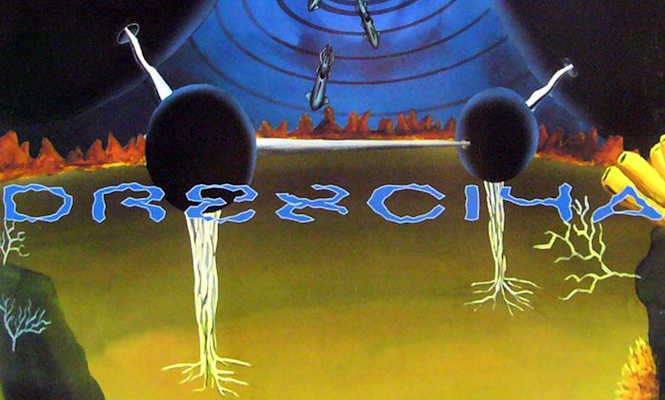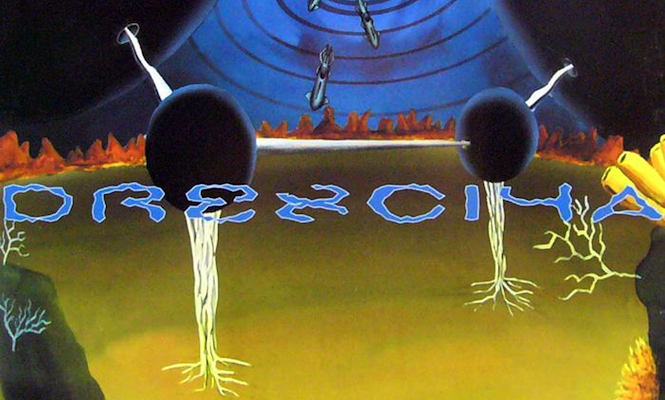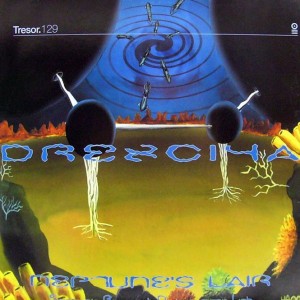Published on
June 26, 2014
Category
Features

After last week’s exploration of Ned Doheny’s neglected yacht soul on Numero Group, we fly off in another direction completely to revisit clandestine techno duo Drexciya and their 1999 debut LP Neptune’s Lair. Strapped into the diving bell, The Vinyl Factory’s Patrick Ryder takes a subterranean plunge to reveal just how many fathoms deep the legacy of this seminal recording goes.
Words: Patrick Ryder
Drexciya
Neptune’s Lair
(Tresor, 1999 / 2014)
When it comes to writing about music, there are a number of traps we need to avoid. For instance, all too frequently we see journalists powerless to resist the king of clichés, the lazy comparison. It’s on account of this offence we’ve heard everyone from James Morrison to James Blunt dubbed the new Dylan as soon as they put finger to fret. Similarly the towering shadow of hype looms large over many a career in print, tricking even the most savvy critic into lavishing praise onto this month’s amplified haircut. But above all else, the most seductive, and destructive, pitfall is that burning desire to turn man into myth, bestowing superhuman qualities and supernatural importance onto something as trivial and quotidian as a record. It’s just as well then, for my sake, that the mysterious Detroit outfit spent their formative years creating a labyrinthine creation myth which fed through every aspect of their music. The musicians in question are the mysterious entity known as Drexciya, and this month sees the reissue of their finest hour.
For the uninitiated, the production duo of James Stinson and Gerald Donald burst onto the scene in 1992 with a debut 12″ on Underground Resistance sub-label Shockwave. The four cuts on ‘Deep Sea Dweller’ showcase harsh and metallic dancefloor techno, deep and atmospheric soundscapes and uplifting machine funk, and was a breath of fresh air in a scene beginning to creak under the weight of an avalanche of releases. The other worldy sounds, a marriage of techno and electro as heard from the ocean floor, came accompanied by the first glimpses of Drexciya’s subaquatic narrative. Pulling together disparate strands of afro-futurism, political activism and Platonic philosophy, the duo formed the detailed mythology of the Drexciyan people, an aquatic race descended from the children of pregnant slaves thrown overboard during the Atlantic crossing. Over the course of a series of well received 12″ on Underground Resistance, Rephlex and Warp, the duo communicated further messages from the Drexciyan race, creating a portal between Africa, contemporary America and the depths of the Atlantic Ocean. And as the myth developed, so did the music.
Originally released in 1999 on Berlin’s uncompromising Tresor imprint, Neptune’s Lair was Drexciya’s debut long player and marked the culmination of the sounds and ideas presented through their early career. Sonically fearless, wildly diverse and melodically unique, the album wowed the techno cognoscenti and wiped the floor with everything else released at the time. Thanks to the heavy shroud of mystery the group wore with pride, details behind the production of the record are scarce, but rumour has it that Stinson created this masterpiece single handedly having split with Donald at some time in the previous year.
The album opens with the moody chant and blurred tongues of ‘Temple Of Dos De Aqua’, immediately transporting us into the deep waters the Drexciyans call home. From this threshold we’re begin our journey to the heart of their world on the electro rhythm and crystalline synths of ‘Andreaen Sand Dunes’. Stinson balances the deep and metallic bassline with the pattering of hi hats while the sounds of submerged transports powering down reverberate through the dark. ‘Running Out Of Space’ takes a dizzying ride through machine funk, careering from eddy to whirlpool while a Parliament bassline rips through the lower frequencies.
As the album plays on, Stinson incorporates echoes of first wave techno, boogie, sci fi noir, John Carpenter sequences and cosmic funk into the Drexciyan lexicon, blending all these ingredients together into a cohesive narrative. The result is an immersive listen, the sonic equivalent of an hour in an isolation tank, floating free in the trippy waters of the Drexciyan dreamscape.
Even the most cursory listen to Neptune’s Lair reveals a legacy of influence on a generation of producers. The thick bassline, irregular rhythm and snapping drums of ‘Habitat ‘O’ Negative’ foreshadow the inter galactic jazz-funk of Maurice Fulton, while ‘Universal Element’s saturated snare and nagging synthlines could easily be mistaken for one of the better L.I.E.S. releases. If you’re a fan of the blurred line between boogie, proto house and electro favoured by Andras Fox, Future Times and Mood Hut, then listen again to ‘Organic Hydropoly Spores’ and you’ll start to realise how far ahead of its time this album was.
Stinson sadly passed away in 2002 but he left behind a flawless body of work, either solo or in collaboration with Donald, and this album was the crowning moment. Neptune’s Lair is Drexciya at its most essential, most mystical and most musical and it’s certain to stand the test of time. If you’re still unconvinced of the importance of the underwater race, I’ll leave you with this. I can still sell twenty copies of an unknown record by saying the simple words “Drexciyan electro”, and if that isn’t star power, then I don’t know what is.







